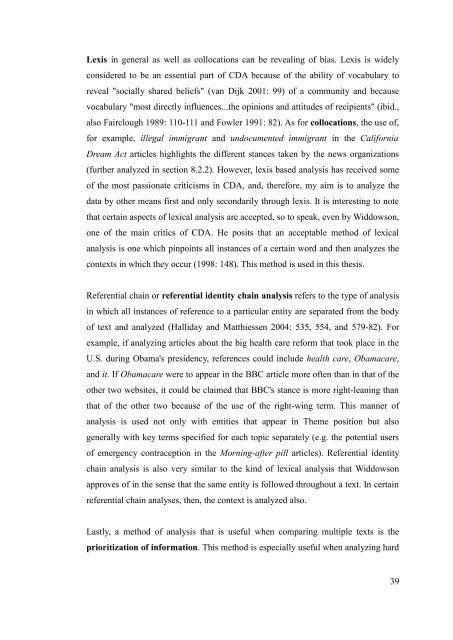Political Bias on BBC, CNN, and Fox News - Doria
Political Bias on BBC, CNN, and Fox News - Doria
Political Bias on BBC, CNN, and Fox News - Doria
Create successful ePaper yourself
Turn your PDF publications into a flip-book with our unique Google optimized e-Paper software.
Lexis in general as well as collocati<strong>on</strong>s can be revealing of bias. Lexis is widely<br />
c<strong>on</strong>sidered to be an essential part of CDA because of the ability of vocabulary to<br />
reveal "socially shared beliefs" (van Dijk 2001: 99) of a community <strong>and</strong> because<br />
vocabulary "most directly influences...the opini<strong>on</strong>s <strong>and</strong> attitudes of recipients" (ibid.,<br />
also Fairclough 1989: 110-111 <strong>and</strong> Fowler 1991: 82). As for collocati<strong>on</strong>s, the use of,<br />
for example, illegal immigrant <strong>and</strong> undocumented immigrant in the California<br />
Dream Act articles highlights the different stances taken by the news organizati<strong>on</strong>s<br />
(further analyzed in secti<strong>on</strong> 8.2.2). However, lexis based analysis has received some<br />
of the most passi<strong>on</strong>ate criticisms in CDA, <strong>and</strong>, therefore, my aim is to analyze the<br />
data by other means first <strong>and</strong> <strong>on</strong>ly sec<strong>on</strong>darily through lexis. It is interesting to note<br />
that certain aspects of lexical analysis are accepted, so to speak, even by Widdows<strong>on</strong>,<br />
<strong>on</strong>e of the main critics of CDA. He posits that an acceptable method of lexical<br />
analysis is <strong>on</strong>e which pinpoints all instances of a certain word <strong>and</strong> then analyzes the<br />
c<strong>on</strong>texts in which they occur (1998: 148). This method is used in this thesis.<br />
Referential chain or referential identity chain analysis refers to the type of analysis<br />
in which all instances of reference to a particular entity are separated from the body<br />
of text <strong>and</strong> analyzed (Halliday <strong>and</strong> Matthiessen 2004: 535, 554, <strong>and</strong> 579-82). For<br />
example, if analyzing articles about the big health care reform that took place in the<br />
U.S. during Obama's presidency, references could include health care, Obamacare,<br />
<strong>and</strong> it. If Obamacare were to appear in the <strong>BBC</strong> article more often than in that of the<br />
other two websites, it could be claimed that <strong>BBC</strong>'s stance is more right-leaning than<br />
that of the other two because of the use of the right-wing term. This manner of<br />
analysis is used not <strong>on</strong>ly with entities that appear in Theme positi<strong>on</strong> but also<br />
generally with key terms specified for each topic separately (e.g. the potential users<br />
of emergency c<strong>on</strong>tracepti<strong>on</strong> in the Morning-after pill articles). Referential identity<br />
chain analysis is also very similar to the kind of lexical analysis that Widdows<strong>on</strong><br />
approves of in the sense that the same entity is followed throughout a text. In certain<br />
referential chain analyses, then, the c<strong>on</strong>text is analyzed also.<br />
Lastly, a method of analysis that is useful when comparing multiple texts is the<br />
prioritizati<strong>on</strong> of informati<strong>on</strong>. This method is especially useful when analyzing hard<br />
39

















